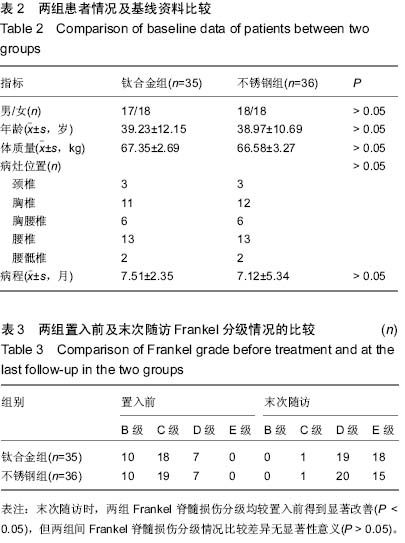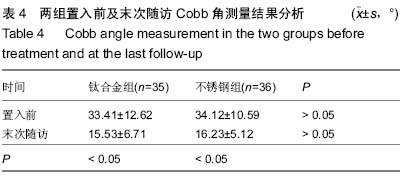中国组织工程研究 ›› 2015, Vol. 19 ›› Issue (30): 4860-4864.doi: 10.3969/j.issn.2095-4344.2015.30.020
• 材料生物相容性 material biocompatibility • 上一篇 下一篇
钛合金与不锈钢内固定材料置入修复脊柱结核的生物相容性
陈 欣,黄亚娟,田 谦,薛 超,李浩鹏
- 西安交通大学第二附属医院骨二科,陕西省西安市 710004
Biocompatibility of titanium alloy and stainless steel internal fixation materials in the treatment of spinal tuberculosis
Chen Xin, Huang Ya-juan, Tian Qian, Xue Chao, Li Hao-peng
- Department of Orthopedics, Second Affiliated Hospital of Xi’an Jiaotong University, Xi’an 710004, Shaanxi Province, China
摘要:
背景:钛合金和不锈钢是两种较为常用的内固定植入材料,但两种材料的治疗效果和生物相容性存在一定的差异。 目的:分析钛合金和不锈钢内固定材料置入治疗脊柱结核的效果及生物相容性。 方法:纳入脊柱结核患者71例,其中男35例,女36例,年龄17-81岁,35例进行钛合金内固定材料置入治疗,36例进行不锈钢内固定材料置入治疗。随访12个月,分析两组脊柱后凸畸形角度变化、治疗效果、Frankel脊髓损伤分级及材料生物相容性。 结果与结论:两组治疗前的脊柱后凸畸形角度、Frankel脊髓损伤分级比较差异无显著性意义,两组治疗后末次随访的脊柱后凸畸形角度、Frankel脊髓损伤分级均较治疗前明显改善(P < 0.05),但两组间比较差异无显著性意义;钛合金内固定组治愈34例(97%),不锈钢内固定组治愈33例(92%),两组间治愈率比较差异无显著性意义。两种材料均具有良好的生物相容性,未发生感染等不良反应。表明在脊柱结核治疗过程中,置入钛合金或不锈钢内固定材料均能获得良好的效果,并具有良好的生物相容性。
中国组织工程研究杂志出版内容重点:生物材料;骨生物材料; 口腔生物材料; 纳米材料; 缓释材料; 材料相容性;组织工程
中图分类号:


.jpg)
.jpg)